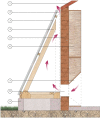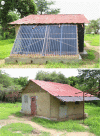Effect of passive and active ventilation on malaria mosquito house entry and human comfort: an experimental study in rural Gambia
- PMID: 37015266
- PMCID: PMC10072938
- DOI: 10.1098/rsif.2022.0794
Effect of passive and active ventilation on malaria mosquito house entry and human comfort: an experimental study in rural Gambia
Abstract
Rural houses in sub-Saharan Africa are typically hot and allow malaria mosquitoes inside. We assessed whether passive or active ventilation can reduce house entry of malaria mosquitoes and cool a bedroom at night in rural Gambia. Two identical experimental houses were used: one ventilated and one unventilated (control). We evaluated the impact of (i) passive ventilation (solar chimney) and (ii) active ventilation (ceiling fan) on the number of mosquitoes collected indoors and environmental parameters (temperature, humidity, CO2, evaporation). Although the solar chimney did not reduce entry of Anopheles gambiae sensu lato, the ceiling fan reduced house entry by 91% compared with the control house. There were no differences in indoor nightly temperature, humidity or CO2 between intervention and control houses in either experiment. The solar chimney did not improve human comfort assessed using psychrometric analysis. While the ceiling fan improved human comfort pre-midnight, in the morning it was too cool compared with the control house, although this could be remedied through provision of blankets. Further improvements to the design of the solar chimney are needed. High air velocity in the ceiling fan house probably reduced mosquito house entry by preventing mosquito flight. Improved ventilation in houses may reduce malaria transmission.
Keywords: Africa; house design; human comfort; malaria; mosquito; ventilation.
Conflict of interest statement
We declare we have no competing interests.
Figures












References
-
- Denyer S. 1978. African traditional architecture. New York, NY: Africana Publishing Company.
-
- Knudsen JB, von Seidlein L. 2014. Healthy homes in tropical zones: improving rural housing in Asia and Africa. Fellbach, Germany: Edition Axel Menges.
Publication types
MeSH terms
Substances
Grants and funding
LinkOut - more resources
Full Text Sources
Medical

